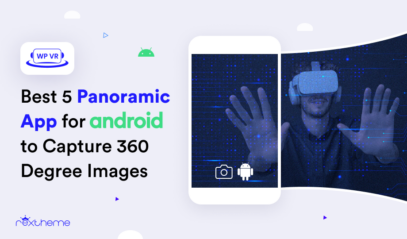Have you ever thought you could enjoy a concert from the comfort of your home and still feel like you’re standing in the front row?
This is the power of Virtual Reality (VR). In 2024, VR isn’t just about gaming—it’s transforming how you work, shop, and learn.
That’s why over 171 million people are using virtual reality!
It’s bridging industries in exciting ways: for real estate, it connects buyers to properties with virtual tours; in hospitality, it links potential guests to immersive hotel previews; and in healthcare, it connects professionals to innovative tools for consultations and patient care.
In this blog, I’ll show you the most exciting virtual reality examples & use cases across multiple industries.
So, let’s start!
10 Virtual Reality Examples of Different Industries
Whether you’re buying a home, planning a trip, or teaching a classroom full of curious minds, virtual reality examples in daily life show how VR simplifies tasks and improves experiences.
Let’s look at some real-world examples where VR is making a difference.
1. Real Estate: Virtual Property Tours
When searching for a flat, you focus on key aspects like room dimensions, layout functionality, natural lighting, and overall aesthetics. VR lets you carefully examine each of these details from the comfort of your home.
You can navigate the property room by room, assessing the living space, bedroom sizes, and kitchen functionality. Instead of imagining how spaces might connect, you can virtually move through the home, observing how the hallway leads to the living room or how the dining area flows into the kitchen.
VR also allows you to inspect the finer points—such as window placement for natural light, ceiling heights, or the quality of finishes like tiles and cabinetry. If the flat is in a multi-story building, VR can simulate the view from the windows or balcony to give you an accurate sense of what it offers.
This detailed exploration means you can evaluate a property’s livability and suitability with precision, showcasing the advantages of virtual reality for home buyers.
2. Tourism: Virtual Travel and Exploration
VR in tourism clears up the ‘what ifs’ when planning a trip. But how does virtual reality work to provide such a seamless preview of destinations and hotels?
Let’s see-
- Hotel Previews: You can walk through hotel rooms to see if they’re as spacious as advertised and check out the pool or lobby for the vibe you’re looking for.
- Destination Walkthroughs: If you’re curious about that hiking trail or resort views, VRlets you explore it all, so there are no surprises when you get there.
- Cultural Tours: Before committing to a trip, you can virtually visit museums or landmarks to see if they’re worth adding to your itinerary.
For businesses, this builds trust. When people see exactly what they’re booking, they’re more confident to hit “confirm.” This means more bookings for hotels or travel agencies and fewer complaints about mismatched expectations.
Read this guide to learn how you can effectively create a hotel virtual tour.
3. Education: Immersive Learning Experiences
Imagine if instead of just describing ancient civilizations to your students, you could actually take them there. They could walk through the streets, see how the buildings were designed, and get a real sense of the culture—all without leaving the classroom.
VR has turned this into a reality for schools and universities, creating immersive learning experiences that captivate students.
Read this guide to learn how you can create virtual school tour
For example, a science teacher can use VR to take students inside the human body, exploring organs in 3D. History lessons can transport students to famous landmarks across the globe, making learning more interactive and memorable.
4. Automotive Industry: Finding Out Suitable Cars From Home
VR’s ability to immerse you in realistic environments doesn’t stop at entertainment because it’s making everyday decisions easier too.
Take car shopping, for example. Instead of visiting multiple dealerships, you can now explore vehicles from your living room.
VR lets you virtually step into a car, examining its exterior design and exploring the interior in detail. From checking the dashboard features to assessing seating comfort, it’s like having a personal showroom right in your home.
This convenience allows you to narrow down your choices before heading to the dealership, saving time and giving you more confidence in your decision.
5. Healthcare Industry: Revolutionizing Treatment and Training
Virtual Reality is becoming a key tool in healthcare, especially for training doctors and treating patients. One of its most significant applications is surgical training.
Doctors can now practice surgeries in a virtual environment which allows them to refine their techniques without any real-life risks.
For example, in healthcare, VR helps professionals with training and treatment, one of the most impactful virtual reality applications in the industry. They can experience realistic scenarios, such as dealing with rare or complex cases, and learn to respond better under pressure.
Shopping has always been about finding the right fit. With VR, the advantages of virtual reality include seeing exactly how items match your space before buying. Shopping has always been about finding the right fit. With VR, the advantages of virtual reality include seeing exactly how items match your space before buying. Using VR in Healthcare you get clearer results with fewer errors and better patient outcomes.
On the patient side, VR is also changing the way treatments are delivered. Pain management apps like RelieVR provide immersive experiences to distract patients during painful treatments.
Similarly, VR exposure therapy is helping individuals with PTSD face and overcome their fears in a safe and controlled setting.
These advancements show how VR isn’t just enhancing medical knowledge—it’s directly improving lives by making treatments more effective and accessible.
6. Retail: Enhancing Shopping Experiences
Shopping has always been about finding the right fit. With VR, the advantages of virtual reality include seeing exactly how items match your space before buying.
Apps like IKEA Place let you see exactly how a chair or table will look in your space before you buy.
This hands-on experience makes a big difference. You can see how products match your home, reducing the chances of buyer regret.
Retailers benefit too, as VR boosts customer confidence and encourages purchases. It’s a win-win, where you feel satisfied with your choice, and brands gain loyal customers.
VR in retail is another example of how this technology is reshaping how we interact with the world—from big decisions like buying a car to smaller, everyday choices. It’s all about putting control in your hands.
7. Exhibitions: Art Galleries and Museums
VR is changing how you experience art and history. Many museums and galleries, like the British Museum, now offer virtual tours, making their collections accessible to people everywhere.
Whether it’s exploring ancient artifacts or modern art installations, you can engage with exhibits as if you were there in person.
This approach removes barriers like travel costs or location limits. It also opens up opportunities for institutions to create interactive experiences, allowing you to get closer to exhibits than ever before. VR enhances visitor engagement by offering a richer, more detailed view of art and history.
8. Fitness and Wellbeing: Innovative Exercise Solutions
VR is making fitness fun and flexible. You may wonder how does virtual reality work to help you join yoga sessions or workout classes in breathtaking virtual settings, whether it’s a serene beach or a lush forest.
These environments make staying active feel less like a chore and more like an enjoyable experience.
This kind of accessibility appeals to a wide range of people. Whether you’re working out at home or looking for a fresh way to stay fit, VR solutions make it easier and more engaging. It’s a creative way to keep up with your fitness goals without stepping into a gym.
9. Events: Conferences & Casual Events
Event planning is seeing big changes with VR.
For example, VR showcases allow you to explore wedding venues or conference setups remotely. You can walk through a space, check out layouts, and see how everything will look before making a booking.
This gives event management companies a new way to market their services. By offering virtual tours, they help you make informed decisions and feel confident about your choices. It’s a convenient, time-saving option for both organizers and clients.
10. Military and Law Enforcement: Simulated Training Environments
VR is also transforming training in the military and law enforcement. It puts you in realistic scenarios—like combat missions or emergency situations—without any real danger. This lets you practice decision-making and sharpen your skills while staying safe.
It’s a straightforward way to experience high-pressure situations and learn how to handle them. Whether it’s tactical drills or response training, VR gives you a chance to build confidence and get better prepared for real-life challenges. It’s practical, efficient, and changing how training works in these industries.
Conclusie
VR is transforming industries in ways that were once unimaginable, offering new ways to engage, train, and market.
Whether it’s enhancing the car-buying experience, revolutionizing healthcare, or creating immersive retail environments, VR is opening up endless possibilities.
As you explore these examples, think about how VR could help solve challenges or create opportunities in your own industry.
WPVR is a tool that makes it easy to create virtual tours and immersive experiences, bringing VR technology to your business. It’s a simple and powerful way to tap into the potential of VR, whether you want to engage customers or enhance training.
As VR continues to shape the future, now is the time to consider how it can bring innovation and growth to your business.
Veelgestelde vragen
How can virtual reality improve user experiences?
The advantages of virtual reality include enhanced immersion, interactive learning, and realistic training environments.
What are some creative ways virtual reality is used at home?
Virtual reality examples in daily life include home design previews, fitness routines, and virtual travel experiences.
Why are industries adopting virtual reality solutions?
Industries use virtual reality applications for cost-effective training, better customer engagement, and innovative problem-solving.









